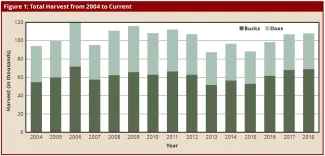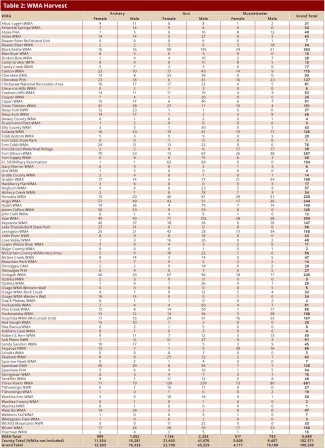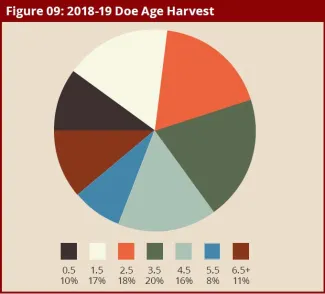
Hunters in Oklahoma are continuing to enjoy some of the most diverse deer hunting opportunities that the country has to offer. Harvest increased slightly from 2017- 18, with a total of 109,260 deer taken in 2018-19.
Figure 1 shows total deer harvest from 2004 through this past season. Doe harvest landed at 36 percent for the season, which is below the target rate of 40 percent to 45 percent. In the westernmost parts of the state, 222 mule deer were taken across 14 counties, which can be seen in Table 3.
Gun hunting continues to be the most common hunt- ing method. Muzzleloader hunters harvested fewer deer compared to last season, but the number of muzzleload- er hunters was down as well.
Archers came up with 26.4 percent of the total harvest, which is consistent with last season’s numbers. The total archery harvest was 28,886 animals. While archery harvest this year did not set a new harvest record as it had in 2016 and 2017, the 2018 archery harvest is the second highest harvest by archers.

Figure 2 depicts the percentage of deer harvest by season. The top three counties in harvest numbers were Osage County with 5,208 deer, Pittsburg County with 3,330 deer and Cherokee County with 2,954 deer.
Table 1 shows harvest by county, season and sex on the state’s private lands. Harvest data from wildlife management areas (WMAs) and other public hunting ar- eas is not included in order to account for counties that lack WMAs.
Oklahoma is dominated by privately owned land, making up about 95 percent of the state. Still, hunters have an abundant chance to use public hunting areas such as Department-managed WMAs, national wildlife refuges, state parks, and recreation areas. Table 2 details deer harvest in these areas by area, season and sex.
Mule deer inhabit the westernmost areas of the state, and they can be harvested using the regular deer license. A total of 222 mule deer were harvested across 14 western Oklahoma counties. Regulations protect antlerless mule deer during gun season; this resulted in only one antlerless mule deer being harvested. Table 3 breaks down mule deer harvest.



Deer Archery Season
In the past two seasons, archers have set new records for single-season harvest. While that wasn’t the case for the 2018-19 season, archers did harvest 28,886 deer, good for second all-time. Their harvest made up 26.4 percent of the overall 2018-19 deer harvest.
Data from the Game Harvest Survey indicates that 100,759 hunters taking to the woods with stick and string during the 3.5-month season.
Regulations remained unchanged for the 2018-19 archery deer season, and the season ran from Oct. 1, 2018, through Jan. 15, 2019. The bag limit was six deer, no more than two of which could be antlered.
A breakdown of buck and doe harvest within each week can be seen in Figure 3. Figure 4 shows archery season hunter numbers and harvest since 2004.


Deer Muzzleloader Season
From Oct. 7 through Nov. 4, hunters had the opportunity to harvest deer using muzzleloading firearms. Bag limits remained unchanged, and hunters could harvest three deer: one antlered, and two antlerless with at least one taken from Management Zones 2, 7, or 8 (refer to the Oklahoma Deer Management Zones map).
The Wildlife Department’s annual Game Harvest Survey estimated 77,618 hunters participated in muzzleloader season. This is a slight de- cline from last season’s 79,248. With the decline in hunters came a decline in harvest.
After the season closed, muzzle-loader hunters had reported 14,306 deer taken, which made up 13.1 percent of overall harvest. That was down 13.6 percent from the 2017-18 season.
Figure 5 shows muzzleloader buck and doe harvest by day. Muzzleloader hunter numbers and harvest from
2004 to current can be seen in Figure 6.


Deer Gun Seasons
The 2018 gun season began Nov. 17 and ran for 16 days. Bag limits remained unchanged from the 2017 season, with hunters having the opportunity to harvest three deer, with no more than one antlered. Hunters had to harvest at least one antlerless deer from Management Zones 2, 7, or 8. A day-by-day breakdown of harvest is shown in Figure 7.
The Game Harvest Survey indicates that 156,152 hunters participated in Oklahoma’s modern gun season, the most popular of all season types. Figure 8 shows harvest and participation data since 2004.
Youth hunters had an opportunity to harvest a deer with a rifle during the dedicated Youth Gun Season, which ran from Oct. 19-21. This resulted in 4,573 deer being harvested.
The Holiday Antlerless Deer Gun Season allowed for one final crack at filling the freezer. Eight of the 10 management zones were open for Holiday Antlerless season, and hunters using the online E-Check system reported 4,228 deer taken.
For all gun seasons combined, a total of 66,068 deer were harvested, which was 60.5 percent of the overall harvest. That number represents a 6 percent increase from the 2017 seasons and the most since 2011 for gun hunters.




Elk
Hunters have opportunities to harvest an elk through the Department’s Controlled Hunts as well as on private lands with the landowner’s written permission. Seasons run concurrently with established deer seasons, except in the Special Southwest Zone.
Elk harvest for the 2018-19 seasons landed at 396, which is down from last year’s 407. Bull harvest made up 179 of the total, while cow harvest accounted for the remaining 217. A breakdown of harvest by county, sex and method of take is shown in Table 4.

Pronghorn Antelope
The Oklahoma Panhandle continues to support pronghorn antelope with populations large enough to allow hunting opportunity. Permits are drawn through the Controlled Hunts program, bought over the counter for archery opportunity, or by landowner tag draw.
These permit allocations resulted in 136 pronghorns being taken in the open zone in the Panhandle. The hunt area includes Cimarron County and western Texas County. Ninety-nine animals were harvested in Cimarron County.
Archers managed to bag 18 bucks and two does, while the rifle hunters checked in 25 bucks and 54 does. Texas County archery hunters added seven bucks, while 13 bucks and 17 does were harvested with a rifle. Table 5 shows a breakdown of pronghorn harvest for 2018.

Conclusions
Big game hunters in Oklahoma continue to have much to be happy about. The state has been blessed with a trend of mild summers, which has helped habitat remain in great shape across most of the state. However, the harvest of whitetail does has been under the management goal of 40 percent now for a handful of seasons, and that fact is beginning to show up with population numbers growing across areas of the state.
It’s again time for hunters to meet the challenge to let young bucks grow and take a doe.
The management of Oklahoma’s deer herd is largely placed on the shoulders of the hunters, as they are the ones managing private property and making harvest decisions. Remember that choosing not to pull the trigger is just as much a management decision as pulling it is.
Hunters must continue to focus on reducing the harvest of young bucks and increasing the doe harvest. The harvest of does will help prevent overpopulation in localized areas; improve an area’s buck-to-doe ratios resulting in a healthier herd; reduce competition for forage and nutrients that encourage greater antler development and growth in bucks; lessen the impact on growing crops, and reduce the risk of disease spread.
Deer hunting is good in Oklahoma. So don’t forget to take somebody new this season; our hunting heritage de- pends on it.
Bear Harvest Record Set for 2018 Seasons
Hunters harvested a record-high 85 black bears in Oklahoma during the 2018 bear archery and muzzleload- er hunting seasons, more than double the total harvest of 40 bears the year before.
“Last year was an excellent year for bear hunters. The weather stayed warm, and that kept the bears and the hunters active,” said Jeff Ford, a wildlife biologist for the Oklahoma Department of Wildlife Conservation.
Modern-day bear hunting began in 2009 in only four southeastern Oklahoma counties: Le Flore, Latimer, Push- mataha and McCurtain. Seasons are held for archery and muzzleloader, and hunters are limited to one bear each year regardless of method of take. A quota of 20 bears is set for the muzzleloader season, but the actual harvest the past few years has not come close to that number.
Le Flore County traditionally yields the highest number of bears each year. In 2018, hunters took 51 bears in Le Flore County. Only four of those were taken with muzzleloaders.
Latimer County yielded 13 bears for the year; Pushmataha County, 20 bears; and McCurtain County, one bear.
In all, 78 bears (43 boars and 35 sows) were harvested during the archery season, and seven bears (four boars and three sows) were taken during the muzzleloader sea- son. Usually about three-fourths of the total bear harvest each year occurs on private land.
The bear seasons coming up this year easily could re- sult in another record-high harvest, thanks to some ma- jor changes in the area open to bear hunting. Beginning in 2019, all or parts of 13 counties are now open for bear hunting in the southeast.
“This year should be another great year for the hunt- ers,” Ford said. “The bears are in the best shape that I have seen in the past several years. We have had above-aver- age rainfall, and the mast crop should be above average.”
Ford said the first week of archery season is when most bears are taken, and the hunters who are out earlier in the season may have better chances for a harvest.
All hunters wanting to pursue a black bear in 2019 must buy either an archery or muzzleloader bear license before the opening dates of each season.
Archery bear season dates are defined by statute, run- ning from Oct. 1 until the third Sunday in October. The 2019 bear season will close Oct. 20. There is no archery season harvest quota.
Muzzleloader bear season will be Oct. 26-Nov. 3, but the season will close as soon as the quota of 20 bears has been reached. Before they hunt, muzzleloader hunters must call for bear quota update information at (888) 901-3256.
For more bear hunting information, consult the Okla- homa Hunting & Fishing Regulations Guide available at www.wildlifedepartment.com, in the “GoOutdoorsOklahoma” mobile app for Apple and Android, or in print free at license dealers statewide.
As black bears become more established in eastern Oklahoma, the chances of people encountering one are in- creasing. To learn more about bears and what to do if you encounter one, go online to www.wildlifedepartment.com/ bear-encounters.